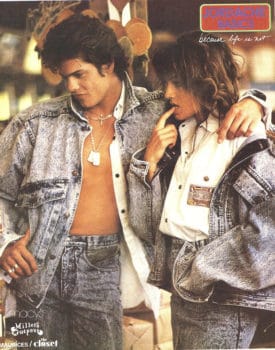
If it wasn’t for the Memphis Group, the 80s as you recognize it may never have happened.
The Memphis Group was an art collective formed in Milan in 1980 by Ettore Sottsass and would be a major influence on the world of art and design. They would go on to create the Memphis Design which gave us the 1980s aesthetic.
Every decade has a certain aesthetic that defines that era. For the 1980s, you can probably picture the bright-pop aesthetic right now. All you have to do is check out that Saved by the Bell opening or any of the binders and folders you probably had in your backpack.
This article is a look back on the Memphis Group and how they defined the look and style of the 80s with their Memphis design
Who Started The Memphis Group?
The focus of the Memphis Group was all about the “Italian-cool” movement and it was started by Ettore Sottsass. Sottsass was always described as a “rebel with a cause” and he was born on September 14, 1917.
Though he was born in Austria, Sottsass would grow up in Turin, Italy and was the son of an architect. This would be an influence on him as far as style and design. Sottsass would end up studying architecture himself graduated in 1939 from the Politecnico di Torino.
His first involvement with artistic groups was when he became a member of the Movimento Italiano per L’Architettura Razionale or the MIAR. This was a modernist architecture group and he would also work alongside his father.
Sottsass and his father looked to create modernist versions of buildings that would change the aesthetic of where they were located. This was after World War 2 so many buildings needed to be created after being previously destroyed or damaged.
The Early Career Of Ettore Sottsass

Sottsass would break free from his father and set up his very own architectural studio where he would also focus on industrial design. IT was at this point he started to look beyond just architecture and how he could lend his design to many different mediums including:
- Ceramics
- Sculpture
- Painting
- Photography
- Jewelry
- Furniture
- Interior design
He also looked beyond just his home country of Italy and moved to New York in 1956. He worked for American industrial Designer George Nelson who had him traveling all over with different projects and assignments. It was also in 1956 where Sottsass would have some of his work commissioned into a ceramics exhibition
Sottsass would eventually return home to Italy and started working with furniture companies as an artistic consultant. He had a unique approach that would also be a radical shift in something as simple as furniture design. It was while working as the artistic consultant that he started to put in place the design aesthetics that would influence the Memphis Design.
Sottsass Starts To Expand His Career
Before the formation of the Memphis Group, Sottsass would work for a famous Italian entrepreneur and politician, Andriano Olivetti. Olivetti hired Sottsass as a design consultant as he liked the fresh and radical approach he saw in his work.
Olivetti had Sottsass design all aspects of his environment including the look of his offices, the design, color, furniture, and even the objects within the office. Sottsass would design mechanical objects like computers and typewriters and this is really where he started to make his name as a unique designer.
He was really creating the first “pop-consumer” objects that made regular items trendy in the same way Steve Jobs would with Apple. Jobs took this similar approach thinking that something bland and mechanical like a computer could actually be a piece of art and even a statement.
Sottsass was using unconventional colors, styling, and form to transform everyday objects into a piece of art – yet still being functional. He was also using some of the colors and designs that would be a part of the Memphis Group and the famous Memphis design.
Due to the success of the work he was doing, Olivetti offered Sottsass a job as a full-time designer along with a massive salary. Sottsass saw this as settling and not allowing to expand and evolve his work so he declined the offer.
Sosstass was ready to branch out on his own.
The Formation Of The Memphis Group
Going into the late 60s and early 70s, many artistic groups were popping up. They were collectives of like-minded people who were interested in creating artistic movements. These collective would all have the same goal of trying to influence the culture with their specific take on design and style.
In 1980 Sottsass founded the Memphis Group with the similar intent of changing the world of architecture, furniture, and overall design. He started it on December 1, 1980, when he first met with a various bunch of designers and artists but it wasn’t officially called the Memphis Group until 1981.
The name Memphis Group has nothing to do with the city but instead comes from a Bob Dylan song. During their first meeting they had Dylan’s “Stuck Inside of Mobile With The Memphis Blues Again” and the name Memphis stood out and was used to name their group.
All of the artists and designers that had met to eventually form the Memphis Group shared similar backgrounds and artistic interests. They were big fans of the art deco movement which had first appeared in France shortly before the First World War started. You can see this Art Deco style reflected in many objects, buildings, art, jewelry, and even vehicles at the time.
A perfect example of the Art Deco style reflected in architecture is the Chrysler Building in New York.
The members of the Memphis Group were also influenced by Pop Art. This is the specific art style from the 1950s that was seen through the United States and Britain. Pop Art was all about the very kitschy and unique. It’s got a very comic book-like look to it and is all about including imagery from pop culture. You would see Pop Art used in many advertisements in the 50s.
The Evolution Of The Memphis Group

The goal of the Memphis Group – and Sottsass himself – was to be innovators while still being provocative and maybe a bit controversial. The group really transcended every type of practice and explored their own curiosities to create art and design.
A big movement for the Memphis group was their post-modernist furniture design that started to capture the attention of the world. Taking their influence from the 1950s, Art Deco, and Pop Art, they started putting out furniture that looked like it was right out of a painting.
Their work featured colorful, geometric-shaped creations that could be seen as odd or bizarre to the regular person. However, this style was embraced by celebrities at the time including Andy Warhol and David Bowie.
Their first big showcase to the world was in 1981 at the Salone de Mobile which was a very important furniture design fair held in Milan, Italy. They debuted many pieces at this fair but primarily it was their furniture that would become the center point.
Every object they created was given the name of a famous hotel such as “Bel-Air” , “Plaza Vanity”, or “Sheraton”. They were simply taking lower budget items and materials and putting them together in this bizarre fashion but then giving them high-end names.
So this new style was confusing some people, but enthralling others. No matter what the reaction there was from people – there was still a reaction and this led to the exhibition being overrun with visitors. Everyone was clambering to see this new “art style” that was being unveiled and there were so many people swarming to get into the building that the Memphis Group thought there had been a terrorist attack when they arrived at the show.
The Memphis Design Is Unleashed On The World
The Memphis Style or Design would be the look that would define the aesthetic of the 1980s. If you want a bit of a more in-depth look at just the Memphis Design, then check out the blog I wrote all about it.
The Memphis Design is all about being radical. It’s a response to the bland, minimal, and practical design that was created in modernism. You can see Memphis Style as a punk rock version of art in response to the elevator music that was modernism.
The Memphis Design is all about those big bold and bright colors, bizarre shapes, and mismatching styles. The colors clash but everything pops, and this was a great way to represent the 1980s.
After the success of the Milan furniture fair, the Memphis Group started to see their influence spread around the world – and into pop culture. This group and their new style were starting to influence many other artists and designers who fully embraced this new radical approach.
The spread of the Memphis Style seemed to work perfectly with the advent of another new radical idea – music television. An all-day music channel was never seen as something practical, but when MTV first debuted in 1981, they changed the way we consume music, and pop culture itself.
It made perfect sense that when MTV first debuted, the Memphis Design was used in their logo, promotion, and introduction. Their first debut to the world – featuring the Moonman – also featured the many shapes, patterns, and colors brought forth by the Memphis Group.
You need to check out the amazing story of the birth of MTV which I wrote all about here.
Continuing To Create The Look Of The 80s

The Memphis Group had now created a full-on movement with their Memphis Style and it was everywhere going into the mid-80s. Pee-Wee’s Playhouse would help to further spread the awareness of this new style as the show was the definition of the Memphis Group and design.
The aesthetic of Pee-Wee’s Playhouse was all about that radical design, and 1950s kitschy apparel. It featured all the designs made famous by the Memphis Group and had a big impact on kids and culture in general.
You would also see the Memphis Design in the opening credits of shows like Saved By The Bell and many networks would incorporate the clashing colors, mix-matched shapes, geometric features, and swirls into their promotional material.
The Memphis Style was now showing up everywhere including clothing, posters, bedsheets, school binders, pencil cases, and many other items.
What Happened To The Memphis Group?
The Memphis Group was starting to slow down going into the late 1980s. By 1988 it was pretty much done but Sottsass had started to slowly remove himself earlier than that. While the Memphis Design was creating the look and aesthetic of the 80s, he was creating a design consultancy which he called Sottsass Associati.
This was all about being able to create architecture on a huge scale and also be able to create designs for international agencies. The Memphis Group was focused on smaller objects, furniture, and general art – but Sottsass wanted to take things in a grander direction.
By 1985, he would leave the Memphis Group to focus solely on Sottsass Associati. The interesting thing about Sottsass Associati is they would be doing what Steve Jobs eventually would with the Apple stores. Sottsass was creating the design and look for the stores of Esprit. He was creating a look and aesthetic that could only be associated with their brand instead of all the other cookie-cutter stores and showrooms out there.
Sottsass Associati still exists today and is based out of London, and Milan. Former members of the Memphis Group still work with Sottsass Associati to continue the direction and philosophy of Sottsass and the group.
The Legacy Of Sottsass & The Memphis Group
As big as the legacy was that he created, more people have become familiar with The Memphis Group as opposed to Sottsass himself. Young designers are coming out of schools and many of them are referencing Memphis as a major influence – but not as many are referencing Ettore Sottsass.
The Memphis Group and design was so massive that it seemed to eclipse that of its own founder. He has left a massive legacy and it’s being shared by museums and exhibitions around the world. 2017 was the centennial of his birth and the Met Breur at the Metropolitan Museum of Modern Art showcased his work to the world.
Sottsass would die on New Year’s Eve, 2007 at the age of 90. His influence on art was profound and the Memphis Group leaves a rich legacy behind as they were able to define an entire era. It’s not often that a look can be representative of a period in time, but the Memphis Group was able to create an aesthetic that is immediately identifiable as the glorious 1980s.



